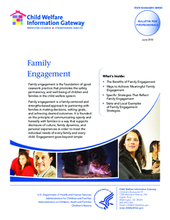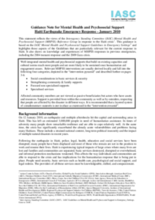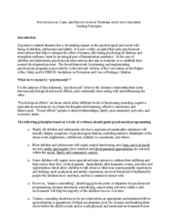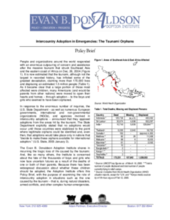Displaying 141 - 150 of 198
Family engagement is the foundation of good casework practice that promotes the safety, permanency, and well-being of children and families in the US child welfare system. This brief offers information to help State child welfare managers improve family engagement across program areas.
The Guidelines from the IAWG provide some of the strongest direction for ensuring emergency efforts protect family unity and avoid child-family separation. Where family unity can not be preserved, these guidelines instruct on tracing and family reunification, care arrangements, durable arrangements, special issues related to refugee children, and promotion of children’s rights.
Provides guidance to organisations working in Haiti about how they can most appropriately communicate with communities, their own personnel and the media. The Guidance Note focuses mainly on the acute phase of the response (including early recovery) and provides basic guidance for action.
Guidance on use of early psychosocial interventions in humanitarian responses to help to mitigate the effect of trauma, alleviating psychological distress, and strengthen resiliency.
Discusses risks associated with using adoption in emergency settings. Additional consideration given on where adoptions can be safely and appropriately facilitated for children with adoptions underway prior to the earthquake.
The Adoption Institute offers this policy brief, with the purpose of examining the role of intercountry adoption in situations such as the one caused by the tsunami – that is, during natural disasters, armed conflicts, and other complex human emergencies
In this Information Note, the Hague Convention urges that the focus in emergencies should first be on child protection, rather than adoption. In the spirit of this Recommendation, it is clear that in a disaster situation, like that brought about by the earthquake, efforts to reunite a displaced child with his or her parents or family members must take priority. Premature and unregulated attempts to organise the adoption of such a child abroad should be avoided.
Address key messages and considerations for preventing separation; ensuring identification, tracing and family reunification is prioritized; and facilitating interim care, alternative care and adoption where necessary.
Using lessons learnt in emergencies, from the genocide in Rwanda to the Asian Tsunami and the earthquake in Haiti, our new report, Misguided Kindness, demonstrates what action is needed to keep families together during crises and to bring separated children back into a safe and nurturing family life.
From preventative strategies to transitional and permanency solutions, the Mockingbird Family Model (MFM) offers a comprehensive support structure for families and children across the continuum of the child welfare experience. This resource briefly describes the MFM and its current activities.








